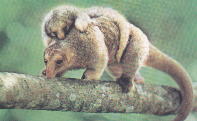

(armadillos, anteaters, and sloths)
Xenarthrans radiated in South America during the Tertiary, when that continent was isolated by sea from other continents. The group currently includes armadillos, 2-toed sloths, 3-toed sloths, and anteaters, placed in four families containing 29 species. These animals are mostly insectivores and herbivores of small to medium body size (up to around 60 kg). In the past, however, xenarthrans were much more diverse and numerous. They radiated into around a dozen families, including not only the groups known today, but also such animals as giant ground sloths, some of which were larger than elephants; glyptodonts, reaching 3 m in length and the most heavily armored vertebrates that ever existed; and a large number of smaller grazing and browsing forms. Several groups of xenarthrans successfully crossed the Central American land bridge to North America when it formed in the Pliocene; these included a number of kinds of ground sloths and armadillos. Only one species, however, an armadillo(Dasypus novemcinctus), is still alive today.
Xenarthrans lack incisors or canines, and if present, their molars and premolars are simply cylinders without the covering of enamel that is found on the teeth of most other mammals. These teeth have a single root. Xenarthrans have small brains, and some have an unusually long and cylindrical braincase. Their tympanic bone is ring-shaped. The most notable feature of their postcranial skeleton are the special articulations (xenarthrous processes) on the lumbar vertebrae. These are found in no other mammals. The number of cervical vertebrae varies from five to nine, depending on the species; this degree of variation is extremely unusual in mammals (almost all other mammals have seven). The forefeet have five toes (with a few exceptions), but two or three predominate and have long, sharp, curved claws. Xenarthrans also have a clavicle and an unusually well-developed coracoid process.
Xenarthrans can be found throughout Central and South America, ranging northwards to the central United States. They are sometimes referred to as edentates (order Edentata). Their fossil record extends to the Paleocene.
Familes Of Xenarthra Family Dasypodidae (armadillos) Family Myrmecophagidae (anteaters) Family Bradypodidae (three toed sloths) Family Megalonychidae (two toed sloths)<<<<<<<>>>>>>> ARTIODACTYLA CARNIVORA CETACEA CHIROPTERA DASYUROMORPHIA DERMOPTERA DIDELPHIMORPHI DIPROTODONTIA HYRACOIDEA INSECTIVORA LAGOMORPHA MACROSCELIDEA MICROBIOTHERIA MONOTREMATA NOTORYCTEMORPHIA PAUCITUBERCULATA PERAMELEMORPHIA PERISSODACTYLA PHOLIDOTA PRIMATES PROBOSCIDEA RODENTIA SCANDENTIA SIRENIA TUBULIDENTATA XENARTHRA
Email: eradani7@aol.com